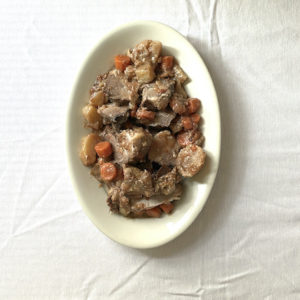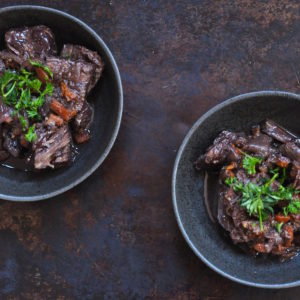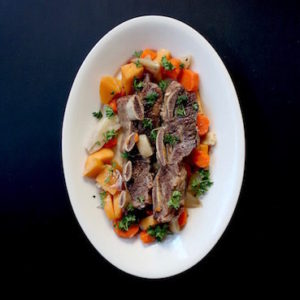Mock Porchetta
Judy Rodgers, writing in the Zuni Cafe Cookbook, describes mock porchetta as
A very modest, very manageable interpretation of the Tuscan “big pig” that few Americans, or Italians, could ever manage at home.
Indeed, this comparatively diminutive roast is nothing if manageable–making it my go-to dinner party dish for decades.

Any meat you purchase, this pork included, will improve markedly by presalting, a truc (French for cooking trick) I learned from Rodgers’s invaluable volume. Up to three days ahead of cooking time, weigh the roast, and rub in one teaspoon of sea salt per pound.
Obviously, sea salts vary; there are fine sea salts, medium grind, and large-grained types like Maldon. My advice is to choose one you like, have easy access to, and to use it consistently. I confess to using Maldon. As salts go, it’s expensive. But I don’t drive a sports car, own fancy jewelry (not, admittedly, that I want any), or go on spa vacations. Maldon salt it is.

(Obvious filler photo.)
Plus, it makes the food taste really, really good.
Presalt all your proteins–poultry, beef, pork, any size, any cut–up to three days ahead, and notice the remarkable difference in taste and tenderness. Not only that, your food likely won’t require additional salt at the table.
Fish, being delicate, and being fish, is another story. Presalt fish only a few hours ahead.
But back to our mock porchetta. You want a three pound/roughly 1.5 kilo pork shoulder roast, ideally on the bone. Most importantly, the meat should be nicely marbled with fat and muscle: as a cooking teacher of mine once said, fat is the messenger of flavor.

The interstices of fat and muscle are important not only for flavor but for what you’ll be carefully tucking inside them: minced capers, aromatic citrus peel, salt, pepper, crushed fennel seeds, and garlic. A little anchovy, if you’re so inclined.

Once you’ve got your aromatics in their pockets, you’ll tie up your roast with kitchen string, presalt it, and tuck it in the fridge, ideally for a few days.

Come cooking time, you can decide whether you want roast vegetables with your mock porchetta, or pair it with something a little lighter.

During the winter months, consider root vegetables like rutabagas, carrots, turnips, potatoes, and garlic, which cook alongside your roast. As I write in late March, the asparagus is coming in, which you can boil or sauté. Or try sautéing green beans and mushrooms in olive oil with plenty of lemon juice.
As for your mock porchetta, this is a low and slow endeavor: 325F (160C) for about three hours.
Hope for leftovers, as they make divine sandwiches, stuffed into rolls with Dijon mustard, pan juices, and salad greens.

Mock Porchetta
With minor changes from The Zuni Cafe Cookbook, by Judy Rodgers
Cooking Time: presalting, which is advisable but not critical, takes 1-3 days. Prepping the roast takes about 30 minutes. Roasting time is 3-3.5 hours
A three pound/1.5 kilo roast makes about six generous servings
Ingredients
One 3 pound/1.5 kilogram pork shoulder roast, preferably bone-in, well marbled and muscled, best possible quality
4 teaspoons sea salt; fine or coarse, divided: 1 and 3. This doesn’t need to be exact.
about three teaspoons freshly ground black pepper
2 teaspoons fennel seeds, bruised
1 tablespoon salt-packed capers, rinsed, patted dry, and lightly chopped
about three sprigs fresh rosemary OR thyme, stripped and crushed; about two teaspoons-this can be approximate
Zest of an organic lemon or orange, finely chopped
three medium garlic cloves, peeled and minced, or equivalent in spring garlic
2 salt-packed anchovies, rinsed, patted dry, and chopped. (if you use anchovies, omit capers.)
Vermouth or white wine, for the roasting pan
Olive oil, for the roasting pan
Optional vegetables, to cook alongside the roast:
halved, scrubbed waxy potatoes
quartered, scrubbed small turnips
quartered, peeled rutabagas
sliced, peeled onions
peeled sliced carrots
whole garlic cloves
shallot lobes
Instructions:
You will need a roasting pan just large enough to accommodate the roast and any vegetables you plan to cook alongside it. I use an old Corningware roasting pan measuring 12 inches long x 7.5 inches wide/28cmx16cm. You’ll also need kitchen string to tie the roast.
* denotes places you can take a break.
Presalting and seasoning the roast:
1-3 days before cooking:
Put the teaspoon of salt, black pepper, fennel seed, capers, fresh herbs, lemon or orange zest and garlic (anchovies, if using) into a small bowl and blend with a fork.
*
Lay the roast on a clean cutting board or prep surface. Using a small sharp knife–a paring knife is useful here–to make several pockets along the natural divisions of muscle and bone. Cut deeply but not all the way through the meat.
Using a measuring spoon or your clean fingers, stuff the seasonings into the pockets as neatly as you can. You probably won’t use all the seasonings, and some will fall out. That’s okay.
*
Tie up the roast:
Cut five or six even lengths of kitchen string. They need to be long enough to circle the roast without invoking Rapunzel. Some people are really into knot technique. I did not learn to tie my shoes properly until age six. Tie the roast loosely at even intervals; you want to keep it together just enough for it to roast evenly. See photo in post.
*
Presalting:
The only tricky part of this. Take the remaining three teaspoons of salt and rub them all over the pork, doing your best not to dislodge your handiwork. It can be done.
Lay the roast into the roasting pan, cover it with foil and refrigerate up to three days.
*
Cooking:
At least an hour before cooking, take pork from refrigerator and allow to come to room temperature.
If you are cooking vegetables alongside the roast, peel, slice, and add them to the pan now. Lightly salt and pepper them.
Preheat the oven to 325F/160C
Add about 1 cup/250 ml Vermouth to roasting pan with about two tablespoons mild olive oil.
Slide pan into oven.
Cook for about three hours, checking liquid level, adding additional water, broth-chicken, pork, or vegetable are all fine–or Vermouth if necessary. Baste if needed. If top of roasting begins browning too much, tently lightly with foil.
Roast is ready when completely tender and pulling slightly from bones, 3 to 3.5 hours.
Serving suggestions: green salad, crusty bread, mustard mashed potatoes, polenta, asparagus, green beans with mushrooms, sauerkraut, sharp mustards, pickles.
Notes:
Minced fresh parsley or oregano also work well in pockets of the porchetta.
Rodgers suggests omitting the above seasonings and using only salt and juniper berries. Serve this roast with sauerkraut.
While leftovers may be frozen up to three months, flavors will suffer. Refrigeration up to four days is preferable.




